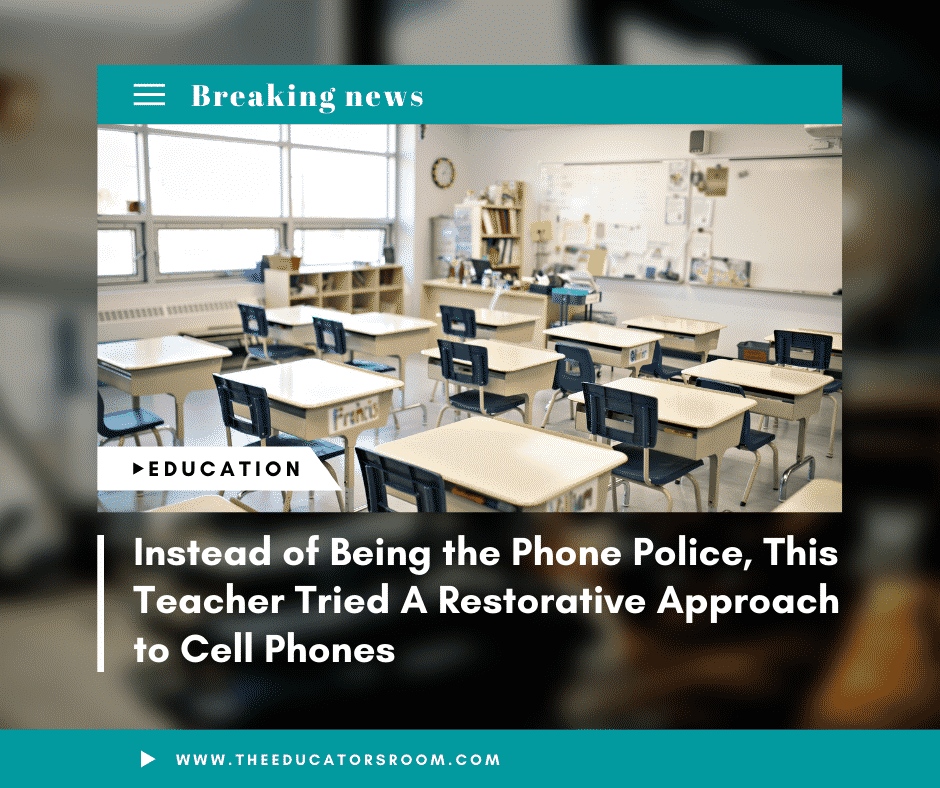If I had a dollar for every time I’ve said “Masks up” and “phones away,” this year, I actually would be in teaching for the money.
After so much time away from in-person school, phones are out more than ever. It’s clear students don’t see anything wrong with checking Snapchat while I’m giving directions or playing Madden in between answering questions about “The Raven.”
Like most schools, we have a cell phone policy, but it is not followed consistently. A teacher who sends a phone to the office will be met with groans of “ugh, I can have my phone out in so and so’s class.”
It’s not that the so and sos don’t care. It’s that they’re tired. We all are.
Teachers are already the mask police, trying to avoid class quarantines and jeopardizing our own safety, so we have neither the desire nor the energy to fight phones too.
We’re in survival mode, and we’re choosing our battles. Or, if you’re like me, you don’t want a battle of any kind, at all.
The World at Their Fingertips
I get it. As a millennial, I am no stranger to phone addiction. I, too, scroll mindlessly through Instagram without really realizing I’m doing it. I definitely pretend to answer texts to get out of the uncomfortable small talk. Googling anything that comes up around the dinner table in 3.2 seconds is a favorite pastime.
I also know that students are not doing their best (or any) learning when their phones are right next to them. Part of my role as their teacher is to provide a structured and supportive environment to help them make smart decisions.
Ideally, my lessons would be so engaging and personally relevant to every single student every single day that they wouldn’t even want to be on their phones. But, the reality is, I teach English and we have to read and write, which isn’t always going to be the most exciting thing for my students. I will do them a disservice if I don’t help them become literate thinkers, clear writers, and coherent communicators.
So, besides expecting all teachers to be unicorns, magically able to captivate 100 teenagers despite the entire internet, what do we do?
Student Voice
I start every class with a circle. We check in on life, make connections to our class content, and usually share a laugh. Because they have helped us build our classroom community, I decided to use one to get honest with them about phones.
I explained my concern that phones were getting in the way of their learning. I also shared how tired I am of asking about masks and phones, and I hate feeling antagonistic.
My solution was to have a phone break in the middle of class. But, instead of implementing it immediately, I asked for their feedback. This showed them that I was indeed not here just to do something to them. I want a solution for us.
As we went around, they could comment on my idea or share what would help them stay off their phones in class.
There were lots of answers to the effect of “I know I need to, it’s just hard.” Several shared, painfully honestly, “If I don’t like what we’re doing or I’m bored, I just go on my phone.” But a few confirmed what I believed to be true, “I use my phone to cope with stress, with everything.”
Students are at their breaking points.
Being back with their peers five days a week has skyrocketed their social anxiety. Teachers are jumping back into their “normal” curriculum and they’re crumbling under the stress. Students have lost loved ones. They’re working and caring for younger siblings.
So, they have a, mostly misplaced, belief that there’s a lifeline within reach at all times. Who can blame them for using it?
A Restorative Solution
After we circled, I thanked them all for sharing their feedback. I promised to incorporate more group work and screen breaks. (Things I’ve been hesitant about with so many students who are quarantined and need to access our work online). I assured them that I would be clear about when phones are okay. (When they’re finished or if they want music during independent reading).
And, most importantly, we’ve tried phone breaks for a few weeks now. I put up a two-minute timer and I don’t talk about anything English-related unless they ask. As the time winds down, I remind them to “snap their last chats” and we dig back into our learning.
Is it a perfect solution? No, a few phones still sneak out, but not nearly as many as before. Do I wish their phones were locked away? Sometimes, but online learning taught us that technology can be an asset in the classroom. It’s much more productive to work with it rather than fight it.
They don’t need me to take their phone if they don’t understand the “why.” If they’re not part of the solution, taking a phone will be a power play, not a learning opportunity. Honestly, I’m just not willing to be their adversary, even unintentionally. I’m not willing to sacrifice our relationship for a mandate.







Hi, I’m currently in a graduate certification program to become a middle school social studies teacher. In my classes, technology, especially phone usage, comes up a lot and many of us have gotten to the point where we know we don’t want to enact the punitive policies we had in school, but we’re also unsure of what to do instead. Thank you for offering a restorative approach in this piece!